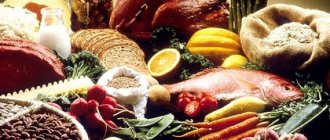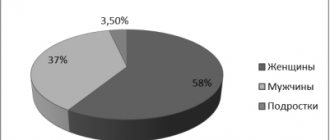- Benefits of potassium and magnesium
- Sources of potassium and magnesium
- When is supplemental potassium and magnesium supplementation necessary?
| If we mostly try to resist hypovitaminosis, then we often forget about the lack of minerals. In winter and in the off-season, we rush to replenish the first aid kit with ascorbic acid, and to strengthen the general immune system, drink some vitamin and mineral complex. |
At the same time, our body may lack very specific minerals, such as potassium and magnesium . Their role in metabolism is far from minor.
Physiological role of potassium and magnesium
Potassium is
the main intracellular ion. The normal functioning of the body depends on the concentration of potassium inside the cell and in the intercellular fluid. Adequate intake of potassium from food ensures the conduction of an electrical impulse, which is necessary for the functioning of the heart and the contraction of smooth and striated muscles, the functioning of the brain and the peripheral nervous system; maintaining intracellular osmotic pressure; water balance. Potassium acts as an activator of certain enzymes; regulator of the activity of voltage-dependent channels; necessary to maintain vascular endothelial function; normal blood pressure (BP); acid-base balance in the body; influences the release of hormones (insulin) [1].
Magnesium
is the eighth most abundant element in the earth's crust, a vital mineral, the second predominant intracellular electrolyte after potassium, and the fourth most abundant cation in the body. Its content in the body of an adult is about 1000 mmol (or 24 g), i.e. 20 mmol/kg of lean body mass. The main depot of magnesium is bone tissue, which contains about 50–60% of its total amount, and about 40–50% in muscles and other soft tissues. It is necessary for muscle relaxation, regulates the mineralization of bone tissue, its uniform growth, flexibility, strength and increases the reparative potential of bones [2].
Approximately one third of bone magnesium is available to maintain levels outside the cell. Extracellular magnesium in the body (less than 2% of total magnesium) is found in blood plasma and erythrocytes [3].
Magnesium is present in all cells as a cofactor of more than 300 enzymes involved in glucose metabolism, the synthesis of proteins and nucleic acids, the formation and transfer of energy, the regulation of vascular smooth muscle tone and the function of endothelial cells, as a counterion for high-energy compounds (ATP) and nucleic acids, regulates transmembrane transport plays a role in maintaining the structure of proteins, DNA stabilization, synthesis and metabolism of catecholamines (norepinephrine), acetylcholine and other neurotransmitters, as well as neuropeptides in brain tissue [4].
Magnesium is necessary for maintaining the homeostasis of calcium, potassium and sodium, plays an important role in the metabolism of vitamin D and the synthesis of its hormonal form, since the activity of enzymes (hydroxylases) that hydroxylate vitamin D3 is magnesium-dependent [5–7].
Potassium: the heart's fiery engine
Potassium is the main intracellular cation, maintaining a certain ratio of concentrations in cells and extracellular space is extremely important for the normal functioning of nervous and muscle tissue. Maintaining the required ratio is achieved through the work of an enzyme that transports potassium ions into the cell and sodium ions out of it. And for the normal functioning of this enzyme, magnesium is necessary. Interestingly, the loss of potassium from the extracellular space is quickly compensated for by its supply from the cells, due to which the concentration of this ion in the extracellular space can remain within normal limits for quite a long time. As a result, critical potassium deficiency, fraught with cardiovascular and neuromuscular disorders, often goes unnoticed in standard studies (Lyashenko E.A., 2012). Potassium deficiency mainly develops due to its insufficient intake from food, intense fluid loss (diarrhea, increased sweating, taking diuretics or laxatives), and also, very importantly, magnesium deficiency. In addition, patients with diabetes are at risk for developing potassium deficiency (Lyashenko E.A., 2012).
Provision of the population with potassium and magnesium
In different countries, the average consumption of potassium is less than 3000 mg/day, and magnesium is 350 mg/day, i.e. lower than recommended by WHO [8]. The average per capita consumption of potassium by the population of the Republic of Sakha (Yakutia) is 2107 mg, and magnesium - 224 mg. In the Sverdlovsk region, insufficient magnesium intake was found in 55% of schoolchildren and 78.8% of industrial workers (with potassium deficiency in 40.4%) [9, 10].
The average potassium intake by adult men in the Stavropol Territory is close to the norm and higher than that of women [11]. Magnesium consumption by persons with cardiovascular diseases (CVD) and obesity in the Moscow region was 326.5 mg, potassium - 3144 mg [12]. Among patients with metabolic syndrome and intestinal dysbiosis, the content of magnesium and potassium in the diet of women is noticeably lower than that of men (304 mg versus 424 mg and 2521 mg versus 3280 mg) [13].
The share of magnesium of aqueous origin in the diets of the population of Primorye is 2.0–7.5%. The use of household water purifiers without a mineralization unit increases the risk of developing magnesium deficiency [14].
Magnesium deficiency occurs in 2.5–15% of cases and is difficult to diagnose because the level in the blood does not reflect the content of intracellular magnesium. The causes of magnesium deficiency are a decrease in its content in food plants, the use of refined and highly processed foods, the presence of chronic diseases, and drug therapy [15].
Hypomagnesemia is diagnosed when the concentration of magnesium in the blood serum is <0.7 mmol/l, with a norm of 0.7–1 mmol/l [16]. In 2117 pregnant women over 18 years of age with clinical manifestations of magnesium deficiency (hypertonicity of the uterus, leg cramps, preeclampsia, neurasthenia), there was a lack of it in the diet in 78.4% of cases, and a reduced level in the blood in 80.9% [17].
Potassium in folk medicine
In folk recipes for the treatment of diseases of the heart, gastrointestinal tract, osteoporosis, nervous system and kidneys, products rich in potassium salts are necessarily used.
The most famous remedy for many diseases
– solution of potassium permanganate, or potassium permanganate. For dysentery, doctors advised taking it both orally and as an enema. But you should prepare the solution very carefully. If you mix it poorly or make it too strong, you can get chemical burns.
For heart problems or water metabolism disorders, folk remedies recommend adding sprouted grains to food. They are rich not only in potassium salts, but also in other useful microelements.
We recommend
“Nutrition for liver restoration” Read more
Grapes are often used in folk recipes as a source of glucose and potassium. It is recommended for kidney health, for diseases of the heart, bronchi, liver, gout, nervous exhaustion and anemia.
In conclusion, we would like to remind you that every coin has two sides. Despite the fact that potassium is very important for our body, it can equally easily cause both benefit and harm. Therefore, do not forget about the norm of consumption, because we ourselves monitor our nutrition, and it is within our power to maintain a balance in the intake of all the necessary elements that are beneficial to health.
Potassium and magnesium deficiency as risk factors for diseases
Potassium.
Arterial hypertension (HTN) is a major risk factor for the development of CVD, stroke and kidney damage and affects approximately 1 billion people worldwide. One of the reasons for the hypertension pandemic in Russia is high consumption of table salt and low consumption of potassium. The ratio of sodium and potassium in urine in hypertension exceeds 5.7 [18].
Moderate intake of potassium from food can lead to a decrease in blood pressure (BP) in people with hypertension, especially in the absence of drug therapy, consumption of large amounts of sodium and/or insufficient potassium (<3500 mg/day). Unlike sodium, potassium increases blood flow and promotes vasodilation as a result of hyperpolarization of the membranes of vascular smooth muscle cells after activation of Na+/K+-ATPase and potassium channels. K+ ions are also released by endothelial cells in response to neurohumoral mediators and contribute to the process of endothelium-dependent vascular relaxation [1].
An increase in potassium intake of 1.64 g may reduce the risk of stroke by 21% (p=0.0007) and CVD in general. Increasing plasma potassium concentrations improves ventricular repolarization and reduces the risk of arrhythmia in patients with hypertension taking non-potassium-sparing diuretics, which may impair glucose tolerance and increase the risk of developing type 2 diabetes mellitus (T2DM) by reducing insulin secretion in response to a glucose load [19]. , 20]. The administration of potassium supplements with thiazide diuretics avoids disturbances in insulin secretion in response to a glucose load [21].
Moderate dietary intake of potassium does not cause severe hyperkalemia or worsening renal function in people with normal renal function, even with renin-angiotensin-aldosterone system blockers. Particular caution should be exercised only in patients with severely impaired renal function [22]. Increased potassium intake is recommended for patients without impaired renal potassium metabolism to control high blood pressure and prevent stroke [23, 24].
Magnesium
is an essential cofactor of more than 40 enzymes necessary for carbohydrate metabolism (hexo- and glucokinase, phosphofructomutase, etc.) and more than 30 enzymes for lipid metabolism (medium-chain acyl-CoA synthetase and long-chain fatty acid ligase, lecithin cholesterol acyltransferase, etc.). Against the background of magnesium deficiency, the activity of these enzymes drops sharply, which contributes to an increase in fat mass, the risk of hypertension, obesity, cholelithiasis, etc. Thus, in patients with obesity and hypertension of the 3rd degree, the level of magnesium in the blood is lower than with hypertension of the 1st degree [25] .
The results of a large-scale Russian study revealed the presence of magnesium deficiency in 47.8% (n=2000) of people who applied to medical institutions. Only 6% of adult patients aged 18–50 years (n=1453) of medical organizations in the Central, North-Western, Northern and Siberian Federal Districts of Russia were provided with magnesium. Magnesium deficiency has been associated with hypercoagulability, neurological pathology (partial epilepsy, neuroses, alcohol dependence syndrome) and chronic inflammation (ulcerative colitis, allergies, coronary heart disease) [3].
Magnesium deficiency is associated with low bone mass and osteoporosis, disruption of the structure (dysplasia) of connective tissue due to destabilization of transport RNA, with a decrease in the activity of hyaluronan synthetases and an increase in the activity of metalloproteinases, hyaluronidases and lysine oxidase [2].
With chronic magnesium deficiency, the Mg2+:Ca2+ ratio is disrupted (normally 1:2) [7]. A higher dietary Mg2+:Ca2+ ratio corresponds to a lower incidence of osteoporosis and increased bone mineral density in men and women [2].
Hypomagnesemia is also a risk factor for obstructive pulmonary disease, metabolic syndrome, T2DM, Alzheimer's disease and CVD [26–31]. It has been shown that an increase in magnesium intake for every 100 mg/day is accompanied by a significant reduction in the risk of stroke by 7%, heart failure by 22%, T2DM by 19%, and overall mortality by 10% [32].
The randomized clinical trial PREDIMED (Prevention with the Mediterranean Diet) found an inverse relationship between dietary magnesium intake and the risk of all-cause and cancer-related mortality. Those with high magnesium intake had a 34% lower risk of death due to lower blood pressure, platelet aggregation, arterial calcification and remodeling; as well as anti-inflammatory effects, improving endothelial function. It acts as a natural calcium channel blocker by competing with sodium for binding sites on vascular smooth muscle cells, increasing prostaglandin E levels, binding to potassium, inducing endothelial-dependent vasodilation and lowering blood pressure. Magnesium is also a cofactor for the enzyme delta-6 desaturase, which limits the conversion of linoleic acid to gamma-linolenic acid, promoting the formation of prostaglandin E1. Its hypotensive effect is potentiated by combination with potassium [33].
By regulating the transmembrane transport of sodium and potassium ions and blocking calcium, magnesium can influence the frequency of cardiac arrhythmias. Its deficiency disrupts the functioning of membrane ATPase and the transfer of sodium from the cell and potassium into the cell. The vasodilating, anti-ischemic, antiplatelet, antiarrhythmic and anti-inflammatory properties of magnesium help reduce the risk of CVD and mortality from them [34].
Magnesium can play a preventive role, preventing the development of T2DM, osteoporosis, bronchial asthma, preeclampsia in pregnant women, migraine and CVD, the formation of kidney stones, the development of cataracts, depression, etc. [15, 35, 36].
Reason to think
Magnesium deficiency manifests itself in a variety of symptoms - from chronic fatigue, decreased mental performance and headaches to arterial hypertension, a tendency to blood clots and cardiac arrhythmias. Increased irritability, depression, anxiety, and sleep disturbances may occur. In addition, spastic contractions of any muscles are possible: skeletal muscle spasms, spastic contractions of the intestines, bronchospasm, increased contractility of the uterus, etc. (Postnikova S.L. et al., 2007). At the same time, additional intake of magnesium in case of its deficiency provides an antiarrhythmic, anti-ischemic effect, helps reduce arterial and intracranial pressure, and has an antispasmodic and anticonvulsant effect. Magnesium is able to normalize blood pressure levels and is effective in therapy for various heart rhythm disorders. In addition, the use of magnesium has a beneficial effect on the functioning of the nervous system and improves sleep. Prevention of magnesium deficiency can significantly reduce the likelihood of developing myocardial infarction (Postnikova S.L. et al., 2007). Potassium deficiency negatively affects the functioning of the cardiovascular system: metabolic disorders and functional insufficiency of the myocardium, arrhythmia, tachycardia, deafness of heart sounds, the occurrence of heart attacks, heart failure, low blood pressure are observed (Kosarev V.V., Babanov S.A., 2012). Potassium deficiency is associated with an increased likelihood of developing arrhythmias and blood pressure levels. Thus, the intake of potassium from food is inversely proportional to the level of blood pressure, and increasing its intake is recommended as a prevention and treatment for arterial hypertension. Also, taking potassium supplements helps to significantly reduce the risk of death from stroke (Lyashenko E.A., 2012).
The need to review potassium and magnesium intake standards
Table 1 presents the recommended intake values (RNI) for potassium and magnesium adopted in different countries, which are periodically reviewed and clarified as scientific data accumulates.
Randomized controlled trials conducted in Europe indicate that potassium intake more than 3500 mg/day has a beneficial effect on blood pressure in adults, and less than 3500 mg/day is associated with a higher risk of stroke and other CVD [37, 38]. ].
Taking into account that a daily potassium intake of less than 3500 mg is associated with an increased risk of stroke due to high blood pressure, the draft standards for physiological requirements for energy and nutrients (2020) for the population of the Russian Federation propose increasing the RDA for potassium from 2500 mg to 3500 mg /day
Due to the fact that magnesium deficiency can cause hypocalcemia and hypokalemia, disrupt the interaction with vitamin D [7] and other substances [38], and also taking into account the experience of the USA and France in the draft norms of physiological requirements for energy and nutrients (2020 .) the RDA for magnesium is expected to increase from 400 mg to 420 mg/day.
Rules for storing and preparing potassium-containing products
Basic requirements for vegetables and fruits
– freshness and absence of damage. There is noticeably less potassium in wilted fruits. It is best to store them in a dry and cool place.
During food processing, the potassium contained in products does not all reach the table; most of it is lost in the process, which is due to the high solubility of salts of this metal in water. For example, cooked spinach has 17% less potassium than fresh spinach. And when cooked, curly cabbage loses up to 50% of the valuable element it contains.
The amount of nutrients in finished food is affected by the cooking temperature, interaction with oxygen, and the acidity level of the dish. Potassium, like most vitamins, is destroyed by strong heat, especially during prolonged cooking. Therefore, you need to cook quickly, trying to reduce the processing temperature as much as possible.
Basic recommendations to help preserve the maximum amount of nutrients, including potassium, in ready-made dishes: do not boil at 100 ° C, do not use a microwave, avoid frying, minimize the amount of vegetable oil. Steamed vegetables are very healthy. But if possible, it is much healthier to eat them raw.
Food sources of magnesium and potassium
A simple and cost-effective strategy for correcting magnesium and potassium deficiency is to replace insufficient dietary intake [39]. Table 2 shows the amount of potassium and magnesium in foods and dishes, the consumption of which makes a significant contribution to providing the body with these minerals.
The main sources of potassium in the diet are potatoes, legumes, vegetables and fruits. Potassium is well absorbed, especially in the presence of pyridoxine (90–95%).
Sufficient intake of magnesium from food is provided by whole grains, green leafy vegetables, nuts, etc. It is also found in plant chlorophyll, sea and blue-green algae. Approximately 10% of the daily requirement for magnesium is met through drinking water [35]. High levels of magnesium in drinking water are an important factor in reducing the risk of death from coronary heart disease, especially among men. The lower limit of magnesium concentration, which is not associated with a risk of CVD, but predisposes to gastrointestinal pathology, is 22 mg/l [40].
Many natural chelators in food products (for example, phytic acid), forming a complex with magnesium, reduce its absorption. Bran bread contains significant amounts of phytic acid. Its content decreases when baking yeast bread, since during the fermentation process the level of phytates decreases significantly [8].
Magnesium absorption is also reduced when consuming vegetables with a high content of oxalic acid and its salts (spinach) compared to low content (cabbage). The absorption of magnesium and phosphates contained in sausages makes it difficult. Inulin promotes the absorption of magnesium. The digestibility of magnesium from mineral waters with its high content approaches 50%, and the absorption of magnesium from food is slightly less (40–45%) [8].
Foods rich in potassium
Sources of potassium for humans are many products, both plant and animal origin. In this table, foods rich in potassium:
| Products | Potassium content (mg/100g) |
| apricots | 340 |
| pineapples | 124 |
| oranges | 166 |
| watermelons | 1705 |
| artichokes | 375 |
| beans | 1020 |
| broccoli | 320 |
| ham | 205 |
| grape | 215 |
| cherry | 289 |
| cabbage | 150 |
| cauliflower | 360 |
| kohlrabi | 420 |
| onion | 250 |
| carrot | 310 |
| nectarine | 167 |
| peach | 150 |
| rhubarb | 310 |
| plums | 85 |
| dates | 510 |
| apples | 108 |
| eggs | 140 |
| cocoa powder | 1660 |
| almond | 780 |
| tea | 2367 |
| coffee beans | 1750 |
| wheat bran | 1150 |
| Pine nuts | 760 |
| almond | 740 |
| peanut | 740 |
| sunflower | 700 |
| walnuts | 440 |
| buckwheat | 380 |
| oatmeal | 350 |
| Wheat flour | 140 |
| rice | 100 |
| hard cheese | 100 |
| beef | 100 |
| pork | 100 |
| herring | 90 |
Those who have been on a strict diet for a long time should definitely pay attention to foods rich in potassium. Especially if laxatives or diuretics were taken at this time. Another category that constantly needs potassium is athletes. During exercise, a large amount of this element is spent to maintain muscle tone. Therefore, after training, a nutritionist prescribes potassium-enriched drinks to prevent a sharp decrease in its level in the body. Each time, those who spent a long time in the open sun (for example, on the beach) and those who had to sweat a lot while treating a cold accompanied by a high temperature will need to replenish the amount of an important element.
Additional sources of potassium and magnesium
In the diet of patients with chronic diseases, pregnant women and other groups of the population, specialized food products and biologically active food additives (BAA) containing significant amounts of potassium and magnesium can also be used [12]. Thus, long-term (more than 4 weeks) intake of potassium as part of dietary supplements by 1900 patients with hypertension contributed to a decrease in systolic blood pressure by 4.48 mm Hg. Art., and diastolic - by 2.96 mm Hg. Art. The most pronounced antihypertensive effect was observed with an initially low (<3500 mg/day) level of potassium intake, high sodium intake (≥4 g/day), a high Na/K ratio in the diet, and the absence of antihypertensive therapy [1].
One of the ways to compensate for the deficiency of potassium and magnesium is the preventive use of salt, in which part of the sodium chloride is replaced with potassium and magnesium salts (68% sodium chloride, 27% potassium chloride and 5% magnesium sulfate). This salt is used instead of regular salt for cooking and adding salt to food.
Dried mineralized seaweed Lithothamnium coralloides
and/or
Lithothamnium calcareum
(6.6%) with 30–34% calcium and 2.3–3.3% magnesium, corresponding to 400–600 mg/100 g soluble magnesium.
The edible seaweeds aosa ( Ulva pertusa
), kelp (
Laminaria japonica
) and others contain 400 to 600 mg of magnesium per 100 g. However, its bioavailability from algae is very low (less than 5%) [41].
In practical medicine, salts of inorganic acids (oxide containing 60% magnesium, carbonate - 28.6%, 7-aqueous sulfate - 9.7%, anhydrous sulfate - 20%), organic acids (magnesium citrate with 15 .8% magnesium, lactate - with 11.9%), chelates with amino acids (magnesium aspartate - magnesium complex 4-water contains 6.6% magnesium). When using inorganic magnesium salts, pregnant women often develop side effects: hot flashes, nausea, headache, decreased heart rate associated with incorrect dosage [8]. Therefore, it is preferable to use its chelates or salts with organic acids (magnesium citrate and magnesium lactate) [17]. Water-soluble citrate is one of the safe forms of magnesium, because it takes part in the Krebs cycle.
Along with single preparations containing potassium (potassium chloride, potassium orotate) or magnesium (magnesium lactate dihydrate, magnesium pidolate, magnesium orotate, magnesium sulfate), complex preparations are used that include both macroelements (potassium aspartate + magnesium aspartate: for example, the drug Panangin). Panangin (1 tablet contains potassium aspartate 158 mg and magnesium aspartate 140 mg) has been used for a long time in domestic and world practice, being one of the most studied and effective preparations of potassium and magnesium aspartate. The undoubted advantage of this drug is the combination of potassium and magnesium, which makes it possible to manifest their synergistic effect [42]. This combination is all the more justified since the metabolism of potassium and magnesium is closely related, and clinically significant hypomagnesemia usually develops against the background of hypokalemia. Aspartic acid, which is part of Panangin, is a natural amino acid that promotes the penetration of potassium and magnesium ions into cells, where it is included in metabolism, being part of many proteins, and also plays an important role in the metabolism of nitrogenous substances, transamination reactions and the formation of pyrimidine bases.
Despite the fact that Panangin contains nutritional substances, it is registered as a medicinal product, since its effectiveness has been confirmed in clinical studies. The maximum daily dose of Panangin in the complex treatment of CVD is 9 tablets, which provides an additional supply of 10% potassium and 27% magnesium from their recommended daily intake. For preventive purposes, the drug is used as a source of potassium and magnesium in a smaller dose (1–2 tablets 3 times a day) [42]. The small content of minerals in 1 tablet allows for fractional administration of this drug throughout the day, which increases the absorption of macroelements.
Potassium in dietary supplements
Dietary supplements contain potassium in bound forms: potassium chloride, potassium citrate, phosphate, aspartate, bicarbonate and gluconate. In potassium iodide supplements, the primary mineral constituent is iodine.
Food manufacturers are forced to limit potassium content to 99 mg, which is about 3% of the daily value. And there are serious reasons for this.
Firstly, studies have found that oral preparations containing potassium chloride, which in terms of net weight contain more than 99 mg of pure metal, are dangerous to health. They can cause damage to the walls of the small intestine.
Secondly, based on the existing health risks, some regulatory organizations require manufacturers to label food products warning that they contain more than 99 mg of potassium.
Potassium is available in tablets, capsules, drops and powder. The use of supplements is only as prescribed by a doctor, since - and this was mentioned earlier - excess potassium is also dangerous to health.
Not much research has been done to determine the effectiveness of potassium supplements. Tests in 2021 showed how well potassium is absorbed in the body. According to the results, about 94% of potassium gluconate is absorbed by the body through dietary supplements at the same rate as if the element came from potatoes.
Previous evidence has been obtained that potassium chloride solution (used as a medicine to treat digitalis intoxication or arrhythmia due to hypokalemia) is completely absorbed within a few hours. But potassium chloride in the form of enteric tablets (their shell prevents the tablets from dissolving in the stomach, but only in the small intestine) is absorbed more slowly than in liquid form.






